| Home > Policy > White Paper, Notice, Announcement > White Paper > FY2003 White Paper on Education, Culture, Sports, Science and Technology >Part1 Chapter2 Section1.1 | ||
From April 2004, Japan will incorporate its national universities. In the 21st century, said to be the age of "knowledge," the responsibility of universities for knowledge creation and its inheritance is becoming more and more important to Japan, which is aiming to develop as an education and culture-oriented nation, and a nation based on the creativity of science and technology. In this sense, universities are required to advance and revitalize their education and research activities in order to meet the expectations of the public and society.
The incorporation of national universities is being carried out with the aim of realizing appealing national universities rich in individuality that actively carry out outstanding education and distinctive research in an environment where universities are autonomous, thereby allowing Japan's national universities to better fulfill their responsibilities.
Previously, various special measures had been taken based on the characteristics of national universities as universities, but they were basically positioned as a part of the government organization. For this reason, the flexible development of education and research was restricted under the Japanese budget system and national public service legal system.
For example, the detailed management restrictions include the following:
It was necessary to incorporate national universities to remove them from this national organizational framework and enable them to make efforts to advance education and research and build universities rich in individuality while developing even more originality and ingenuity than previously, based on more independence, autonomy and self-responsibility.
In Europe and the United States, universities, including national and state universities, are generally given corporate status and this has tended to result in more autonomous environments developing. Based on these facts, since the 1971 Central Council for Education Report, the incorporation of national universities has often been suggested, but the right time for reform has never emerged, and the suggestions were thus never acted upon.
After that, taking advantage of the announcement of the policy to introduce the independent administrative institution system predicated on financial measures by the government, it was decided to study the transformation of national universities to independent administrative institutions "as a part of university reform respecting the independence of universities" (Cabinet decision, April 1999), and a study concerning the incorporation of national universities was commenced. Specifically, the "Study Team concerning the Transformation of National Universities into Independent Administrative Corporations," composed of people involved with national universities and experts from public and private universities and the economic world, was established within the then-Ministry of Education, and in cooperation with the Japan Association of National Universities, a discussion was held over a 20-month period about the appropriate corporation system for national universities. In March 2002, a Final Report entitled "The New Vision of the National University Corporation" was compiled.
Based on this Final Report, and utilizing the framework of the independent administrative institution system as well as sufficiently taking into account the special characteristics of university education and research, the National University Corporation Bill was drawn up, stipulating the "new national university corporations" in a form incorporating a specific mechanism that contributes to university reform. In conjunction with this, individual bills were drawn up to transform the institutions of national colleges of technology into independent administrative institutions, such as the Independent Administrative Institution National Colleges of Technology Institution Law, the Independent Administrative Institution National Institution for Academic Degrees and University Evaluation Law, the Independent Administrative Institution National University Finance and Management Center Law, and the Independent Administrative Institution Media * Education Development Center Law, and in February 2003, along with the preparatory bill to carry out the necessary amendments to related laws, they were submitted to the Diet as six bills related to the National University Corporation Bill. After that, the bills were deliberated on in the Diet and enacted. In this way, it was decided that from April 2004, national universities would become national university corporations ( Figure 1-2-1 ).
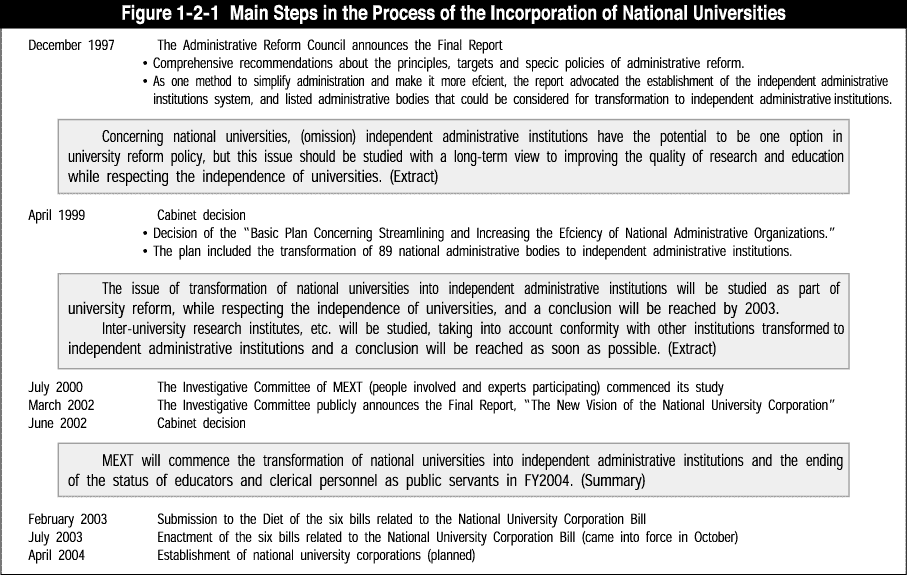
| * Media |
A method of distributing information.
The incorporation of national universities aims to expand greatly the managerial discretion of universities and revitalize education and research as well as improve their quality in a more autonomous environment by making national universities independent institutions, each possessing their own corporate status, in order that national universities may more successfully fulfill their role in meeting the expectations of the public and society ( Figure 1-2-2 ).
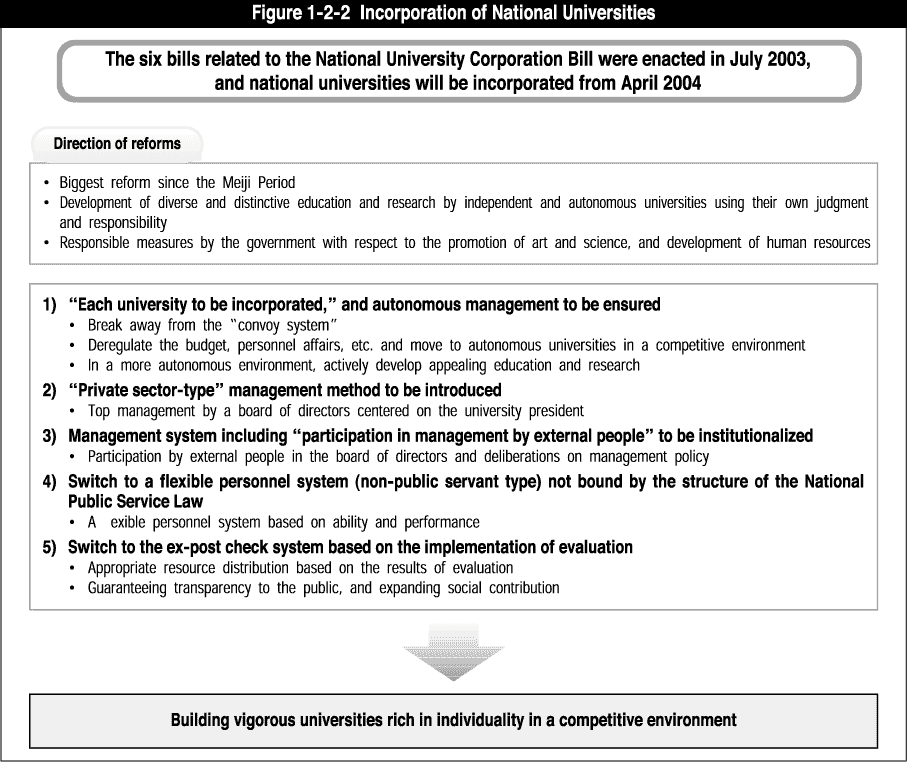
Specifically, the following fundamental reforms of the items considered to be management issues for national universities are proceeding:
| 1) "Each university to be incorporated," and autonomous management to be ensured |
Concerning the unit when incorporating national universities, as it is the natural approach to increase the independence and autonomy of university management and strengthen self-responsibility and can be expected to contribute to the fomenting of a competitive environment between universities and the individualization of universities, a mechanism is being employed to confer corporate status on each university. In order for each university to proceed with "building universities of radiant individuality" that bring out their individuality and distinctiveness, it is important for each university to increase autonomy by having its own corporate status, competing with each other and aiming for further revitalization.
As stated above, national universities until now have been basically positioned as a part of the government organization (an internal organization of MEXT). Therefore, they have been subject to a variety of national regulations with respect to budgets, organization and personnel affairs, and their relationship with the national government meant the daily and wide-ranging participation of MEXT in national university management.
The incorporation of national universities aims to achieve a major transition away from this kind of relationship between the national government and national universities. The basic philosophy is to relax or abolish the daily participation of the national government and the various regulations, greatly expand the managerial discretion of universities and institutionally limit the participation of the national government to the area of the medium-term target period (six years) [the "entrance"] and the area of ex-post achievement evaluation, etc. [the "exit"].
By stipulating the establishment and abolition of universities in law, and responsibly carrying out necessary financial resources measures, etc., the responsibility of the national government towards education and research in national universities is to be fulfilled.
| 2) "Private sector-type" management method to be introduced |
It can be said that until now, the management of national universities has been carried out by the national government (namely, MEXT) in the sense that national universities were subject to various national government regulations especially concerning the budget and organization. After transformation to national university corporations, management authority and responsibility is to be transferred to the heads of universities (namely, the university presidents), and there is to be a switch to a mechanism that realizes top management centered on the university president.
The National University Corporation Bill stipulates mechanisms such as the following:
These regulations make it possible for the university president to manage national university independent corporations with strong, resolute leadership.
Concerning management and organization, "councils" in national universities are currently established as university-wide deliberative bodies dealing with all aspects of university management. Yet, it has been suggested that because the councils are composed of members such as internal faculty representatives, it takes time to coordinate opinions between faculties, and as a result they are sometimes a barrier to flexible university management.
On the other hand, with the transformation to national university corporations, new authority and responsibility concerning management will devolve to universities, so it is important to put in place a management system that makes flexible decision making on the responsibility of universities themselves more possible than before.
From such a viewpoint, the National University Corporation Bill places particular importance on: 1) making the location of authority and responsibility concerning management and education clear; and 2) obtaining the participation of external people, and coordinating opinions within the university. As a result, the law includes the establishment of two deliberative bodies: "education and research councils," which deliberate on important items concerning university education and research such as university-wide curriculum policies, etc., and "management consultation committees," which deliberate on important items concerning national university corporation management such as drawing up budgets, etc. Based on the results of these deliberations, important items are voted on at board of directors meetings and this mechanism makes it possible to secure flexible and accurate decision making.
| 3) Management system including "participation in management by external people" to be institutionalized |
Under the National University Corporation Bill, the mechanism to employ external people as board directors is to be introduced with the aim of directly reflecting the specialized knowledge of external people in the management of national university corporations. For this reason, for example, it is expected that experts on university management and specific specialized fields will be employed widely from outside the university, including people from the economic sector or private universities, or professionals with advanced specialized skills.
It is assumed that human resources possessing outstanding knowledge and abundant experience in fields for which it is difficult to employ people internally, such as fields concerning management, including finance, labor management and publicity, will be employed as external trustees. They could be employed from a wide range of fields, for example people with experience managing companies, people with experience managing school corporations, and people involved in the media. Because external auditors are required to audit from a more specialized and neutral perspective regardless of whether the execution of operations and accounting at national university corporations is being carried out appropriately, people involved in school corporations and people involved in auditing corporations could be employed as external auditors.
The university president is responsible for carrying out the specific selection of external trustees, taking into account the situation and the management strategy of the national university corporation.
Furthermore, after the transformation to national university corporations, the realization of flexible, strategic university management from a university-wide perspective under the leadership of the university president will be required. But on the other hand, with a view to placing importance on accountability to the public and society, ensuring the transparency of the decision-making process and securing a fair decision-making process, it is necessary to have a mechanism to reflect actively external opinions and make daily external inspections of university management possible.
In particular, national universities are supported by public expenditures, so it is necessary to sufficiently reflect the opinions of taxpayers in their management. For this reason, it has been determined that the majority of members of the management consultation committees are to be external members. The education and research councils, which carry out deliberations with respect to education and research, are in composed in principle of only internal people. In this way, the overall balance between external and internal is taken into account in this mechanism.
In order to widely obtain suitable people to be university presidents, who are to be the officials with final responsibility for both management and education in national universities after the transformation to national university corporations, selection of university presidents is to reflect internal opinions with respect to both management and education, take care to reflect external opinions, and be carried out at the university president selection council, composed of an equal numbers of representatives of external members of the management consultation committee and representatives of the education and research council.
| 4) Switch to a flexible personnel system (non-public servant type) not bound by the structure of the National Public Service Law |
To revitalize the organization as well as education and research in a competitive environment, and further increase autonomy, it is necessary for national universities to manage the personnel affairs of their faculty members more flexibly.
From such a viewpoint, in the Final Report of the Investigative Committee, concerning the status of faculty members in national universities after the transformation to national university corporations, it was stated that it was appropriate not to give them public servant status and made the following recommendations concerning the realization of a flexible personnel system:
In light of this Report, it was decided not to give public servant status to faculty members at national university corporations (non-public servant type), and that a mechanism is to be put in place to make it possible to provide each faculty member the job content and conditions that correspond to his or her motivation and abilities and to establish opportunities for diverse activities utilizing the faculty member's knowledge and experience.
Based on the independence and autonomy of national university corporations, they are to decide salary payment standards themselves. It is possible to introduce a variety of salary systems, such as the selective annual salary system and a salary system that incorporates work sharing, * as well as to make decisions of the starting salary when employing human resources from the private sector and others, or flexible salary grading when promoting and/or raising the salaries of current employees.
As for industry-academia cooperation activities and contribution to the local community, the rules concerning faculty members holding more than one job are to be stipulated by each respective individual national university corporation in its employment regulations in conformity with its own principles and targets. For example, it will be possible, by the decision of a single national university corporation to position activities treated as a side job outside the appointed position as a duty of the faculty member, and to promote further restoration to society of national university research results. It will also be possible to recognize the double employment of private company executives and regular employees not only in the case of executives of Technology Licensing Organizations (TLOs), but also for executives of companies utilizing research results and corporate auditors, already allowed under specific conditions. Furthermore, if employment in a side job within normal working hours on weekdays contributes to industry-academia cooperation and local communities, then a side job in which working hours are allocated to these times may be approved.
| 5) Switch to the ex-post check system based on the implementation of evaluation |
As the independence and autonomy of university management after the incorporation of national universities increases, the necessity of clearly disclosing to the general public the state of universities also increases further. For this reason, evaluation has a very important role to play.
In addition, universities develop diverse and advanced education and research activities based on their respective philosophies and targets, so when implementing evaluation it is important to do so based on these special characteristics of universities. The supplementary resolution in the Diet in the vote on the Corporation Bill states that, "Concerning the evaluation system under the National University Corporation Law and the relationship between evaluation results and resources distribution, based on the intent of Article 3 of the Law, efforts must be made to manage it carefully, and ongoing review must be carried out."
| * Work sharing |
Sharing of the total amount of paid labor among many people by reducing the actual working hours per person with the objective of reducing unemployment.
As an evaluation mechanism, the following process is being considered, but the specific details are to be studied by the National University Corporation Evaluation Committee and MEXT:
The medium-term targets and the medium-term plans of national university corporations, based on the mission and functions expected of national universities, clarify the targets that national university corporations should aim for over a six-year period and form policies to make those targets more specific into a plan.
The medium-term targets are to be stipulated by the Minister of Education, Culture, Sports, Science and Technology after consulting the National University Corporation Evaluation Committee because financial measures are required to implement the operations necessary for their achievement. In that case, however, it is stipulated in the National University Corporation Law that it is necessary to take into account the opinion (original plan) of national university corporations, based on the special characteristics of universities, and the bodies that actually draw up the medium-term targets are to be the national university corporations themselves. In addition, the Minister of Education, Culture, Sports, Science and Technology is to approve the medium-term plan to achieve the medium-term targets after consulting the National University Corporation Evaluation Committee, but in this case too, it is necessary to take sufficiently into account the special characteristics of education and research. For this reason, it is required in a supplementary resolution of the Diet that the Minister of Education, Culture, Sports, Science and Technology should strive to ensure the transparency of the decision-making process by publicly disclosing the reasons for any modifications to the original medium-term targets and medium-term plan and the opinion of the National University Corporation Evaluation Committee, and that modifications to the original plan are possible only when they are absolutely unavoidable for financial reasons ( Figures 1-2-3 and 1-2-4 ).
With the incorporation of national universities, the special account for national educational institutions is to be abolished, and national financial measures for national university corporations are to include measures for administrative expense subsidies for project costs required by operations management, and measures for facilities development expense subsidies for costs required by the development of facilities.
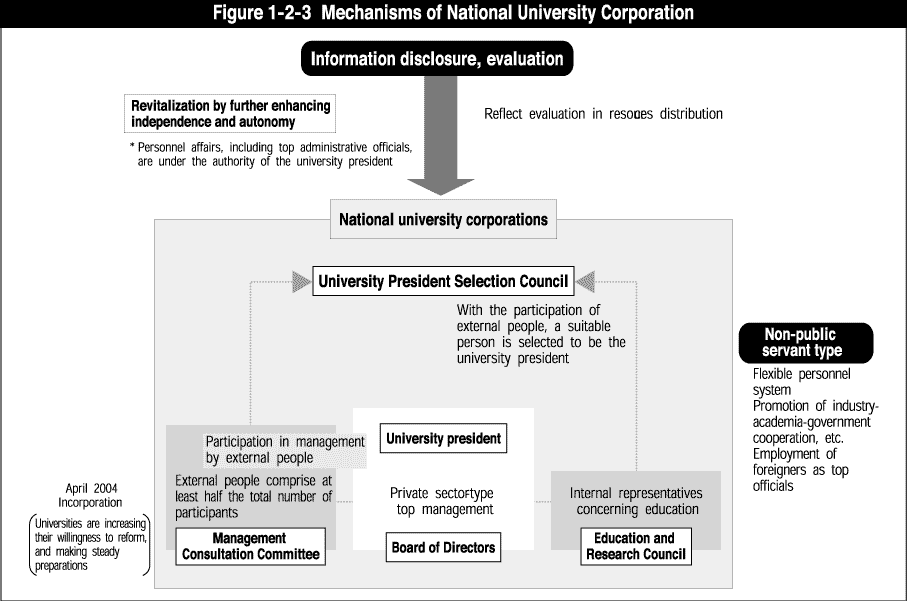
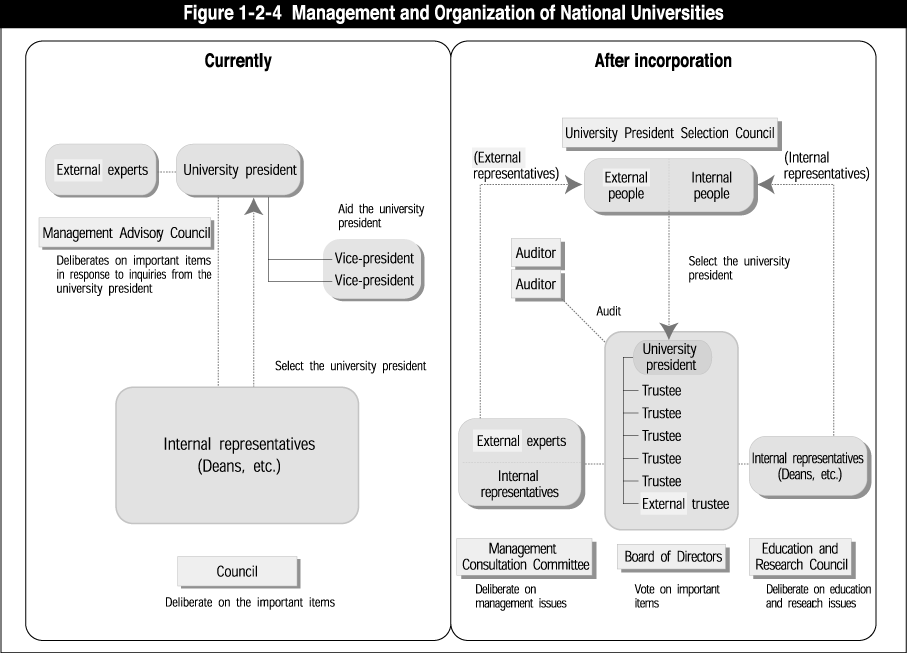
Comparing administrative expense subsidies with the current special account for national educational institutions in terms of budget execution, the following modifications are to be carried out:
As a result of these modifications, flexible execution based on the independent judgment of national university corporations will be possible, and the results of management efforts will be directly shown in the corporation's financial accounting.
National facilities development expense subsidies are the basic revenue source for facilities development, but to achieve the diversification of revenue sources and stable development, a system has been set up to make facilities development utilizing long-term loans, proceeds from the sale of land and other self-revenues possible. Furthermore, regulations and administrative procedures will be greatly relaxed as, for example, restrictions under the National Assets Law will be removed, etc., and facilities development based on the independent judgment of universities will be possible.
Inter-university research institutes, by establishing and managing large-scale research facilities and equipment, or gathering and organizing a large amount of scientific information and data, play an important role in the development of scientific research in Japan as institutions that provide these facilities or information for joint use by researchers in universities, etc. nationwide and promote effective and efficient research. Furthermore, inter-university research institutes cooperate with university education such as the acceptance of graduate school students, etc. and implement integrated research and education.
Research institutes that aim to carry out research in specific fields were formerly established in affiliation with specific universities. However, with developments in scientific research, it has become necessary to have an organization in which it is possible to bring together researchers and implement research crossing individual university boundaries with a nationwide perspective. In 1971, for the first time, the National Laboratory for High Energy Physics was established as an inter-university research institute not affiliated with a specific university. Currently, 15 institutions and 18 research institutes (the Institute of Space and Astronautical Science was merged with the Japan Aerospace Exploration Agency on 1 October 2003) have been established.
Some affiliated research institutes have also been turned into national joint-use institutes as developments in scientific research have led to an increase in the necessity and effectiveness of proceeding with research carried out by researchers jointly. Inter-university research institutes are thus being established, taking into account trends in scientific research and the opinions of researchers at a time when it is thought for the following reasons that having a research institute not affiliated with a specific university would be effective in terms of promoting joint use:
Concerning the incorporation of inter-university research institutes, the April 1999 Cabinet decision stated that the "incorporation of inter-university research institutes will be studied, taking into account conformity with other institutions that are to be transformed to independent administrative institutions, and a conclusion will be reached as soon as possible." A subsequent study, however, has been carried out in combination with the study of national universities in light of the similar nature of inter-university research institutes and national universities. Specifically, from July 2000, a combined study was carried out of inter-university research institutes and national universities by the Study Team concerning the Transformation of National Universities into Independent Administrative Corporations, and in March 2002, the Final Report was completed.
On the other hand, under the auspices of the Science Committee of the Council for Science and Technology, the Inter-University Research Institutes Special Committee was established and the ideal reorganization of inter-university research institutes and the ideal system design after incorporation of inter-university research institutes were studied. In February 2003, the Final Report of the special committee was completed (and approved in April 2003 as the Science Committee Final Report).
Based on these reports, the following measures are to be taken when incorporating inter-university research institutes:
1) By reorganizing the current 13 institutions and 16 research institutes into four research organizations and incorporating them, revitalize Japan's overall scientific research and strengthen international competitiveness, such as securing autonomous management, and promote strategic efforts to create new academic fields
2) By making researchers non-public servants, realize treatment (salary, etc.) corresponding to the efforts and performance of researchers, and revitalize diverse activities of researchers such as industry-academia-government cooperation, etc.
3) By allowing the participation of external people as directors, etc. and introducing top management by a board of directors, realize transparent, flexible and strategic management
4) By switching to an ex-post check system based on the introduction of third-party evaluation, evaluate the efforts and performance of research institutes appropriately, and develop inter-university research institutes individualistically
The incorporation of inter-university research institutes is expected to contribute to the development of scientific research in Japan, including the advancement of research and the revitalization of management, through the innovation and efforts of each research institute in an environment of expanded autonomy ( Figure 1-2-5 ).
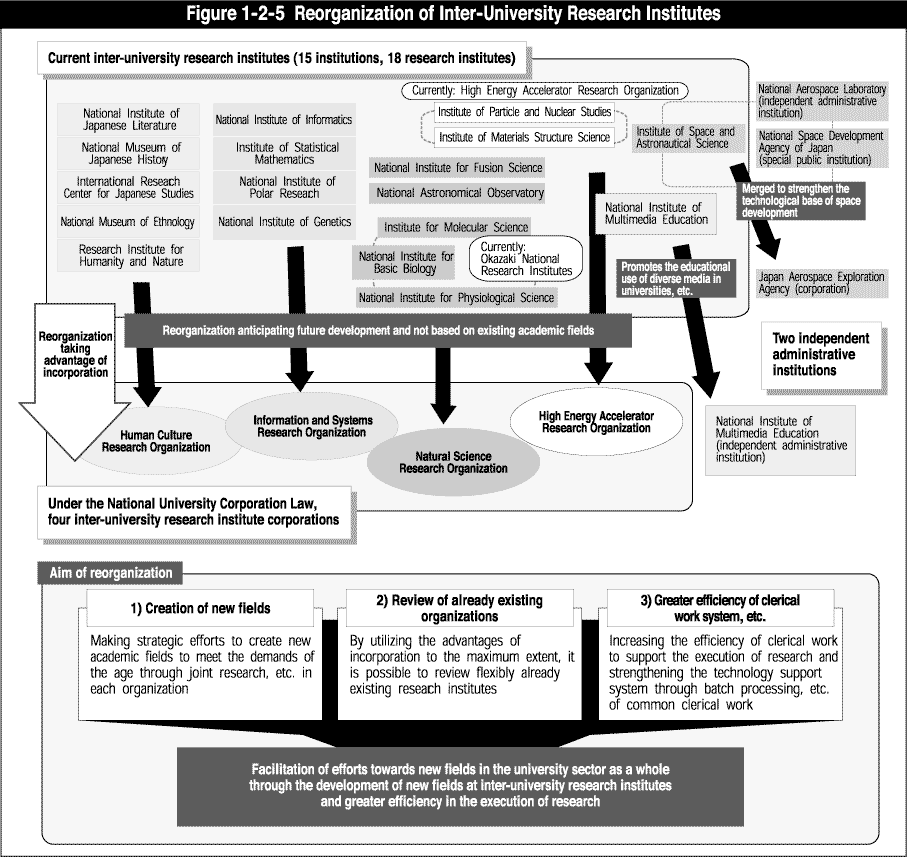
| Back To Top | MEXT HOME |